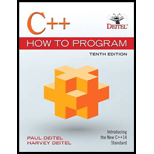
C++ How to Program (10th Edition)
10th Edition
ISBN: 9780134448237
Author: Paul J. Deitel, Harvey Deitel
Publisher: PEARSON
expand_more
expand_more
format_list_bulleted
Question
Chapter 7, Problem 7.20E
Program Plan Intro
Title: What does the
Expert Solution & Answer
Trending nowThis is a popular solution!

Students have asked these similar questions
4. |z + 5 - 5i| = 7
14.
dz,
C: |z❘
C: |z❘ = 0.6
ze² - 2iz
H
14.
dz,
C: |z❘
C: |z❘ = 0.6
ze² - 2iz
H
Chapter 7 Solutions
C++ How to Program (10th Edition)
Ch. 7 - Exercises 7.6(Fill in the Blanks) Fill in the...Ch. 7 - (True or False) Determine whether each of the...Ch. 7 - (Write C++ Statements) Write C++ statements to...Ch. 7 - (Two-Dimensional array Questions) Consider a...Ch. 7 - (Salesperson Salary Ranges) Use a one-dimensional...Ch. 7 - (One-Dimensional array Questions) Write statements...Ch. 7 - (Find the Errors) Find the error(s) in each of the...Ch. 7 - (Duplicate Elimination with array) Use a...Ch. 7 - Prob. 7.14ECh. 7 - Prob. 7.15E
Ch. 7 - (Dice Rolling) Write a program that simulates...Ch. 7 - ( What Does This Code Do?) What does the following...Ch. 7 - (Craps Game Modification) Modify the program of...Ch. 7 - (Converting vector Example of Section 7.10 to...Ch. 7 - Prob. 7.20ECh. 7 - (Sales Summary) Use a two-dimensional array to...Ch. 7 - (Knight's Tour) One of the more interesting...Ch. 7 - (Knight's Tour: Brute Forty Approaches ) In...Ch. 7 - (Eight Queens) Another puzzler for chess buffs is...Ch. 7 - (Eight Queens: Brute Force Approaches) In this...Ch. 7 - Prob. 7.26ECh. 7 - (The Sieve of Eratosthenes) A prime integer is any...Ch. 7 - Prob. 7.28RECh. 7 - (Eight Queens) Modify the Eight Queens program you...Ch. 7 - (Print an array) Write a recursive function...Ch. 7 - Prob. 7.31RECh. 7 - Prob. 7.32RECh. 7 - (Maze Traversal) The grid of hashes (#) and dots...Ch. 7 - Prob. 7.34RECh. 7 - Making a Difference 7.35 (Polling) The Internet...
Knowledge Booster
Similar questions
arrow_back_ios
SEE MORE QUESTIONS
arrow_forward_ios
Recommended textbooks for you
 C++ Programming: From Problem Analysis to Program...Computer ScienceISBN:9781337102087Author:D. S. MalikPublisher:Cengage Learning
C++ Programming: From Problem Analysis to Program...Computer ScienceISBN:9781337102087Author:D. S. MalikPublisher:Cengage Learning C++ for Engineers and ScientistsComputer ScienceISBN:9781133187844Author:Bronson, Gary J.Publisher:Course Technology Ptr
C++ for Engineers and ScientistsComputer ScienceISBN:9781133187844Author:Bronson, Gary J.Publisher:Course Technology Ptr Microsoft Visual C#Computer ScienceISBN:9781337102100Author:Joyce, Farrell.Publisher:Cengage Learning,
Microsoft Visual C#Computer ScienceISBN:9781337102100Author:Joyce, Farrell.Publisher:Cengage Learning, Programming with Microsoft Visual Basic 2017Computer ScienceISBN:9781337102124Author:Diane ZakPublisher:Cengage Learning
Programming with Microsoft Visual Basic 2017Computer ScienceISBN:9781337102124Author:Diane ZakPublisher:Cengage Learning

C++ Programming: From Problem Analysis to Program...
Computer Science
ISBN:9781337102087
Author:D. S. Malik
Publisher:Cengage Learning

C++ for Engineers and Scientists
Computer Science
ISBN:9781133187844
Author:Bronson, Gary J.
Publisher:Course Technology Ptr

Microsoft Visual C#
Computer Science
ISBN:9781337102100
Author:Joyce, Farrell.
Publisher:Cengage Learning,

Programming with Microsoft Visual Basic 2017
Computer Science
ISBN:9781337102124
Author:Diane Zak
Publisher:Cengage Learning